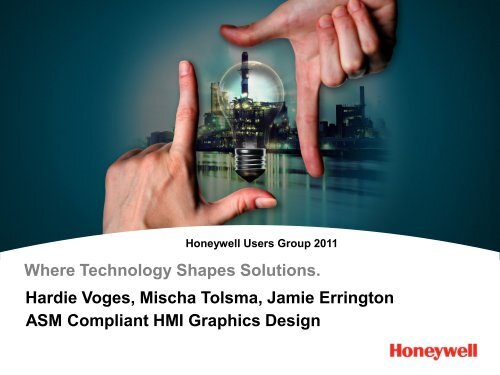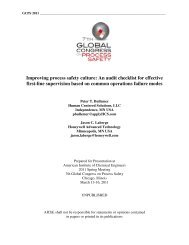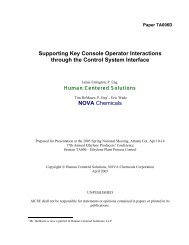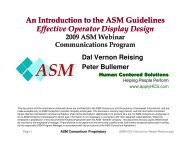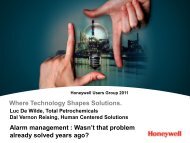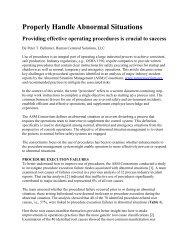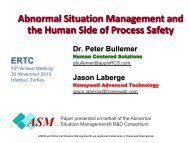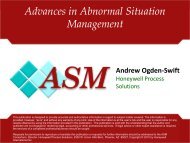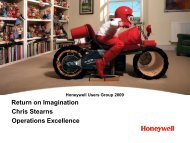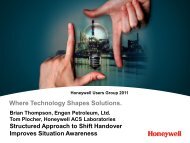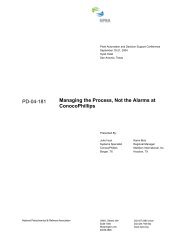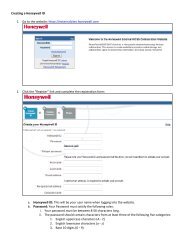ASM Compliant HMI Graphics Design for ... - ASM Consortium
ASM Compliant HMI Graphics Design for ... - ASM Consortium
ASM Compliant HMI Graphics Design for ... - ASM Consortium
Create successful ePaper yourself
Turn your PDF publications into a flip-book with our unique Google optimized e-Paper software.
Honeywell Users Group 2011<br />
Where Technology Shapes Solutions.<br />
Hardie Voges, Mischa Tolsma, Jamie Errington<br />
<strong>ASM</strong> <strong>Compliant</strong> <strong>HMI</strong> <strong>Graphics</strong> <strong>Design</strong>
Introduction<br />
– Integrated oil and gas company with substantial chemical interests in<br />
Africa, Europe, Asia & North America<br />
– Member of the <strong>ASM</strong>® <strong>Consortium</strong><br />
– World leader in Fischer-Tropsch expertise<br />
• Complemented by interests in technology development and oil and gas<br />
exploration and production<br />
– Major production facility in Secunda, South Africa<br />
Human Centered Solutions<br />
Helping People Per<strong>for</strong>m<br />
– Human Factors design company<br />
• Provides comprehensive Human Factors designs & products to improve<br />
Operator Effectiveness<br />
– Member of the <strong>ASM</strong>® <strong>Consortium</strong><br />
2
Team<br />
• Hardie Voges<br />
– Chief Technologist, Sasol Synfuels<br />
– Degree in Computer Science (B.SC. Hon IT)<br />
– 15 years instrumentation and control experience<br />
• Mischa Tolsma<br />
– Engineering Manager, Sasol Synfuels<br />
– MSc and PhD in Applied Physics<br />
– Interests include Abnormal Situation Management, Real-Time<br />
Dynamic Optimization and Work Process <strong>Design</strong><br />
• Jamie Errington<br />
– Senior Partner, Human Centred Solutions<br />
– Degree in Chemical Engineering<br />
– 25 years process control and project engineering experience<br />
3
Introduction<br />
• Outline<br />
– DCS replacement project Rectisol<br />
– Replacing all TDC technology with Experion C300<br />
– <strong>Design</strong>ing a new Human Machine Interface according to the<br />
Abnormal Solutions Management (<strong>ASM</strong>) guidelines.<br />
– What is <strong>ASM</strong><br />
– <strong>Design</strong> approach<br />
– Challenges and mitigation plans<br />
– Successes achieved<br />
– Other changes<br />
– Path <strong>for</strong>ward<br />
– Conclusion<br />
4
Rectisol DCS Project<br />
• TDC 2000 replacement Rectisol West<br />
– TDC was installed in 1978, it did exceptionally well but:<br />
• Bathtub curve effect – increasing failure rate<br />
• Spares availability – some spares no longer available<br />
• Ability to maintain – resources<br />
• Available spare capacity - Limited to no capacity <strong>for</strong><br />
expansion<br />
• Lack in functionality – need more advance functions<br />
• In 2008 Sasol decided to replace the TDC 2000 system<br />
with Experion C300 DCS system<br />
5
Rectisol DCS Project<br />
• The hardware replacement was relatively easy.<br />
– The complete hardware change over was done during a two<br />
week shutdown – September 2009<br />
• The challenge faced was the <strong>HMI</strong><br />
What to do<br />
6
<strong>ASM</strong><br />
Abnormal Situation Management®<br />
A Joint Research and Development <strong>Consortium</strong><br />
Founded in 1994<br />
Creating a new paradigm <strong>for</strong><br />
the operation of complex<br />
industrial plants, with<br />
solution concepts that<br />
improve Operations’ability<br />
to prevent and respond to<br />
abnormal situations.<br />
Human Centered Solutions<br />
Helping People Per<strong>for</strong>m<br />
www.asmconsortium.org<br />
Sasol joined <strong>ASM</strong> in 2006<br />
7
Business Impact<br />
<strong>ASM</strong><br />
What is an Abnormal Situation<br />
• An industrial process is<br />
being disturbed and<br />
the automated control<br />
system can not cope<br />
• Consequently, the<br />
operations team must<br />
intervene to supplement<br />
the control system.<br />
Loss of Life<br />
Personal Injury<br />
Equipment Damage<br />
Environmental Release<br />
Public Relation<br />
Product Throughput<br />
Product Quality<br />
Job satisfaction<br />
An Abnormal Situation Impacts Process Safety<br />
8
<strong>ASM</strong><br />
<strong>ASM</strong> in relation to Process Safety Mgt.<br />
Safety Pyramid Illustration<br />
Process<br />
Safety<br />
Incidents<br />
Abnormal<br />
Situation<br />
Incidents<br />
Ineffective<br />
Operations<br />
Practices<br />
Major Incidents<br />
Incident above threshold<br />
<strong>for</strong> Process Safety Incident<br />
Minor Incidents<br />
Incident below impact threshold<br />
<strong>for</strong> PS Incident<br />
Near Miss<br />
System failure that could lead to an incident<br />
Unsafe Behaviors<br />
Illustration based on: CCPS Process Safety Leading and Lagging Metrics.<br />
9
<strong>ASM</strong><br />
<strong>ASM</strong>® <strong>Consortium</strong> Guidelines<br />
• Initial <strong>ASM</strong>® Research<br />
– Started in 1994 with multiple site-assessments<br />
• Determined breadth of the <strong>ASM</strong> problem<br />
– AEGIS (Abnormal Event Guidance and In<strong>for</strong>mation System)<br />
• Developed prototype of technologies that could avoid abnormal<br />
situations or manage improved response<br />
• Site Assessments and Research<br />
– Led to the development of <strong>ASM</strong>® Effective Practice G/Ls<br />
• Effective Operations Practices<br />
• Effective Operator Display <strong>Design</strong><br />
• Effective Alarm Management Practices<br />
• Effective Procedural Practices<br />
– Initially internal documents – now three are published<br />
10
Auto Filter<br />
Emergency<br />
Status Time/Date<br />
Age<br />
Type<br />
Evidence Response<br />
Source<br />
10:14:34 12/15/96<br />
00:00<br />
Trip<br />
Trend<br />
Advisory<br />
Log<br />
History<br />
Active UIN<br />
UIN Library ChronicAlarms<br />
9:44:34 12/15/96<br />
Name<br />
Overhead Receiver Pressure PC204<br />
Ralph<br />
FIDev<br />
JoeTime<br />
Joe F<br />
Remind<br />
14<br />
100<br />
Anna5Anna<br />
Timer<br />
Ralph6Ralph<br />
FIDev<br />
Ralph4Ralph<br />
Remind<br />
80<br />
Ralph2Ralph<br />
TIChng<br />
13<br />
Anna1Anna<br />
TIChng<br />
60<br />
PV SP OP<br />
12<br />
30 Minute<br />
40<br />
11<br />
Intervene Investigate Watch...<br />
20<br />
10:14:34 12/15/96<br />
00:00Request<br />
10:14:34 12/15/96<br />
00:15PVDEVHI<br />
00<br />
Deactivate New >><br />
Edi t>><br />
ACK<br />
X<br />
Feed Preheat<br />
Combustion Riser/Regen<br />
Air<br />
Fractionator<br />
Waste Heat<br />
Control<br />
Note<br />
Log<br />
Specs<br />
Configure<br />
Overhead<br />
H Naphtha<br />
LCO<br />
Evidence<br />
Receiver<br />
Compressor<br />
Reflux<br />
HCO<br />
Feed Preheat<br />
Combustion Riser/Regen<br />
Air<br />
Fractionator<br />
Waste Heat<br />
Control<br />
Note<br />
Log<br />
Specs<br />
Configure<br />
Overhead<br />
H Naphtha<br />
LCO<br />
Evidence<br />
Receiver<br />
Compressor<br />
Reflux<br />
HCO<br />
<strong>ASM</strong><br />
Initial <strong>ASM</strong> Operator Interface Concepts<br />
Trend Window<br />
Status Window<br />
Waste Heat<br />
175#<br />
Atmosphere<br />
Steam<br />
Trend Window<br />
Feed Preheat<br />
Fractionator<br />
-35<br />
Riser/Regenerator<br />
Documentation Task Window<br />
- 45<br />
Goals/Plans/Actions Window<br />
Specifications on<br />
Things<br />
-35<br />
-15<br />
+102<br />
-35<br />
•malfunction<br />
•goals<br />
•alarms<br />
•plan 1 status<br />
•plan 2 status<br />
•plant3 status<br />
•This is a<br />
Combustion Air<br />
•message<br />
•plan 4 status<br />
• string of text<br />
•plan 5 status<br />
•Describing s<br />
•stuff<br />
-10<br />
Notifications Window Operations Window Operations Window<br />
Diagnostic Window<br />
Ralph15 Author<br />
Objective<br />
• Define concepts and features that<br />
improve usability and<br />
effectiveness of the humanmachine<br />
interactions in the<br />
process control operations<br />
environment<br />
Key Solution Concepts & Innovations<br />
• Single, Integrated View of Multi-Level<br />
Hierarchy<br />
• Mixed Initiative Approach<br />
• Effective Window Management and Layout<br />
• Effective Navigation Scheme<br />
• Visual Coding Scheme<br />
• Interaction Objects<br />
• Contextual Menus & In<strong>for</strong>mation Presentation<br />
• Task View Organization<br />
11
<strong>ASM</strong><br />
<strong>ASM</strong> Supervisory Control Model<br />
• Based on Human In<strong>for</strong>mation Processing model<br />
• Includes Psychological stages of Situation Awareness<br />
Process<br />
State<br />
Operator Mental & Physical Activities<br />
Orienting<br />
Evaluating<br />
Acting<br />
Inputs from Process<br />
(sensors, analyzers, radios,<br />
video, instructions, sounds &<br />
smells)<br />
(1) Sensing,<br />
Perception,<br />
and/or<br />
Discrimination<br />
(2) Analysis,<br />
Interpretation,<br />
and/or<br />
(3) Projection<br />
Physical and/or<br />
Verbal<br />
Response<br />
Outputs to Process<br />
(SP, OP%, Manual<br />
adjustments)<br />
Situation Awareness (1-3)<br />
Internal Feedback<br />
Assessing<br />
External Feedback<br />
12
<strong>ASM</strong><br />
Effective Operator Display <strong>Design</strong><br />
13
What Makes an Operator Interface <strong>ASM</strong> <strong>Compliant</strong><br />
• It is much more than a display with a grey background!<br />
• Sasol implementation meets over 90% of the <strong>ASM</strong>®<br />
<strong>Consortium</strong>’s 81 Effective Operator Display <strong>Design</strong><br />
Guidelines<br />
• “Cherry picking”<br />
select Guidelines<br />
may not lead to<br />
an effective<br />
interface<br />
14
Sasol Required an Operator Interface:<br />
Hardwired<br />
switches,<br />
buttons, etc.<br />
Key<br />
Variable<br />
Display<br />
Alarm<br />
Summary<br />
Type 1<br />
Overview Trends<br />
Optional –<br />
Hardwired<br />
switches,<br />
buttons, etc.<br />
Business LAN<br />
PC<br />
Business LAN<br />
PC<br />
Radio,<br />
Telephone,<br />
Dedicated<br />
lines, etc.<br />
Type 2 &<br />
Control Zone<br />
Type 3, 4 &<br />
Demand Trend<br />
Type 2 &<br />
Control Zone<br />
Type 3, 4 &<br />
Demand Trend<br />
Optional –<br />
Radio,<br />
Telephone,<br />
Dedicated<br />
lines, etc.<br />
Keyboard<br />
Keyboard<br />
Primary Position<br />
Keyboard<br />
Secondary Position<br />
+50°<br />
+60°<br />
<strong>Design</strong>ed <strong>for</strong> the Console Operator:<br />
• View Angles<br />
• Secondary support position<br />
• Ancillary equipment<br />
+10°<br />
0°<br />
-15°<br />
-30°<br />
+35°<br />
+15°<br />
0°<br />
-15°<br />
-35°<br />
-50°<br />
-60°<br />
-70°<br />
15
Multi-Window Operator Interface<br />
Level 1<br />
Console-wide Overview<br />
Level 2<br />
PFD Summary<br />
Level 3<br />
P&IDs / Tasks<br />
Tag Detail<br />
Level 4<br />
Multi-Faceplate<br />
• Tag Level 4 Detail – 23 1 Multi-Faceplate<br />
– PFD P&ID – Custom Console-wide Summary / Task Faceplate Overview<br />
•<br />
Display<br />
Supports Provides Focus Instrument Tag task summary details specific with or of activities Task-specific large “strip-chart” blocks (control, of function trend console logic, displays etc.) area<br />
– Provides high-level assessment of span of control<br />
<strong>for</strong> console operator<br />
16
Display Coordination<br />
• Linked Displays<br />
– Selecting a target<br />
on an upper level<br />
display<br />
– Automatically<br />
opens more<br />
corresponding<br />
detailed displays<br />
• Selected tag is<br />
put in Focus<br />
– Opens new<br />
Faceplate<br />
– Detail Trend<br />
12<br />
Selecting Target on Upper Level Display<br />
12<br />
Focus Tag & Trend<br />
12<br />
12<br />
12<br />
12<br />
12<br />
12<br />
12<br />
12<br />
12<br />
12<br />
12<br />
12<br />
12<br />
12<br />
12<br />
12<br />
12<br />
Corresponding<br />
12<br />
Level 12 3<br />
12<br />
12<br />
12<br />
& Level<br />
4<br />
12<br />
12<br />
12<br />
12<br />
12<br />
12<br />
12<br />
12<br />
12<br />
12<br />
12<br />
12<br />
12<br />
12<br />
12<br />
12<br />
12<br />
12<br />
12<br />
12<br />
12<br />
12<br />
12<br />
12<br />
12<br />
12<br />
12<br />
12<br />
12<br />
12<br />
12<br />
12<br />
12<br />
12<br />
12<br />
17
<strong>HMI</strong> <strong>Design</strong> Methods<br />
• The design process consisted of four phases.<br />
% Involvement<br />
Engineering<br />
Operations<br />
Maintenance<br />
18
<strong>HMI</strong> <strong>Design</strong> Methods<br />
• Phase 1 Process<br />
– Collects in<strong>for</strong>mation, MFD’s<br />
– Arrange meeting with operations management to discuss<br />
process. Establish team.<br />
– Arrange first workshop with operations and maintenance<br />
– Explain design process, Level 1,2,3,4<br />
– Compile MFD’s into process flow hierarchy<br />
• Phase 2 Process<br />
– Build graphics using process flow hierarchy starting at level 3<br />
– Arrange review session and correct deviations.<br />
– This phase should not take more that four sessions<br />
– <strong>Graphics</strong> must be design to cater <strong>for</strong> needs not wants<br />
19
<strong>HMI</strong> <strong>Design</strong> Methods<br />
• Phase 3 Process<br />
– Finalize graphics<br />
– Train maintenance and build in all the links<br />
– Arrange review session with production<br />
– Maintenance to lead review session and test all links on<br />
graphics<br />
– Maintenance to correct minor deviations<br />
• Phase 4 Process<br />
– Load graphics on system to be CFAT<br />
– All deviations must be recorded<br />
– Maintenance to correct deviations and production to sign off<br />
graphics <strong>for</strong> operation<br />
20
Obstacles Encountered<br />
• The <strong>HMI</strong> design was not without problems.<br />
• Obstacles<br />
– Operator resistance to change<br />
– Operator lack of participation in the design process<br />
– Operator lack of participation in the CFAT<br />
• Operator perception<br />
– Paradigm shift to control via graphics instead of groups<br />
– Navigation between four screens on quad will be a problem<br />
– Grey color scheme will not make operating easier<br />
21
Overcoming Obstacles<br />
• The <strong>HMI</strong> team tried to overcome the problems by.<br />
• Overcoming obstacles<br />
– Making the operators part of the change, giving them<br />
ownership<br />
– Negotiating overtime <strong>for</strong> operators partaking in the design and<br />
CFAT process<br />
– Taking the workshop offsite to limit distractions<br />
• Overcoming operator perception<br />
– Giving the operators extensive training on the navigation of<br />
the graphics and the colors used<br />
– Incorporating the old groups into the level 4 graphics<br />
22
Benefits of New <strong>HMI</strong><br />
• Some benefits achieved<br />
– Newer operators more relaxed, no need to remember group<br />
numbers<br />
– Training time <strong>for</strong> new DCS operators has been reduced, due<br />
to existing plant knowledge<br />
– After shutdown Rectisol started up first time<br />
– Operator more attentive to color changes<br />
– Tab navigation makes it easy to navigate to problem area<br />
– Improved fault finding capabilities <strong>for</strong> maintenance personnel<br />
23
Other Changes<br />
• New console design<br />
– <strong>Design</strong>ed a new console with adjustable work areas to cater<br />
<strong>for</strong> all operators<br />
– Incorporate other interfaces into new console (fire and gas,<br />
Moore PLC, personal computer, Vibration monitoring)<br />
• Control room.<br />
– Upgrade lighting <strong>for</strong> optimum working conditions<br />
• Alarming<br />
– Implemented a distinctive alarm sound <strong>for</strong> each console and<br />
each alarm priority (critical, high and low)<br />
– Followed a alarm rationalization process to optimized the<br />
alarms and reduce nuisance alarms<br />
24
Secunda Path Forward<br />
• Implementation completed at 3 other plant<br />
• Future plan to roll out process to rest of Sasol<br />
Synfuels<br />
• To upgrade control rooms<br />
• To upgrade consoles<br />
• Build new centralizes control rooms<br />
• Upgrade from TDC to Experion<br />
25
Project Summary<br />
• The project has succeeded in:<br />
– Manage a successful changeover from TDC to Experion<br />
– Manage a successful <strong>HMI</strong> design approach with operations<br />
– Manage a successful implementation of the new <strong>HMI</strong><br />
– Manage a successful startup with a totally new system<br />
– Manage to create a improved training environment <strong>for</strong> new<br />
DCS operators<br />
• But you can’t win all:<br />
– Alternative plan required <strong>for</strong> personnel close to retirement<br />
26


